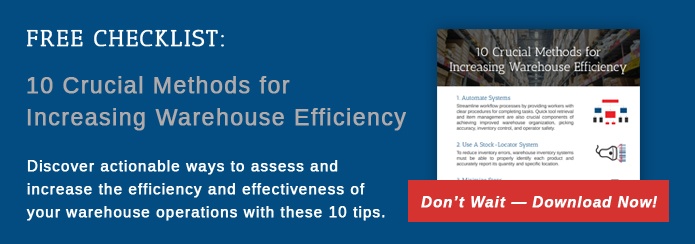 First In First Out (FIFO) rotation of physical goods is usually regarded as the gold standard for managing inventory. Despite this, many companies don't attempt to follow FIFO or do so only loosely. This can be due to obstacles that they face implementing a FIFO process, or a failure to fully appreciate the benefits that they can realize by strictly enforcing FIFO. Let's take a closer look at how FIFO works for physical inventory, where you might encounter issues, and when it is a good fit for your organization.
First In First Out (FIFO) rotation of physical goods is usually regarded as the gold standard for managing inventory. Despite this, many companies don't attempt to follow FIFO or do so only loosely. This can be due to obstacles that they face implementing a FIFO process, or a failure to fully appreciate the benefits that they can realize by strictly enforcing FIFO. Let's take a closer look at how FIFO works for physical inventory, where you might encounter issues, and when it is a good fit for your organization.
Cons of FIFO
If FIFO was easy, everyone would do it. Here are some of the more commonly cited reasons why companies don't use FIFO.
Requires Better Systems for Compliance
In a really small environment, FIFO can be enforced with the concerted effort of a small staff. In a normal warehouse, human management becomes significantly more difficult. The sheer volume of goods entering and leaving the space in any given time period, combined with the layout and accessibility of stock in your warehouse, usually require at least some system upgrades in order to enforce FIFO. For FIFO to truly work, it needs to be consistently enforced, and some form of automation and management system will be needed to make that possible.
Can Be Difficult to Track at Scale
Along the same lines, tracking your FIFO efforts can be difficult at scale. If you have a large warehouse space, SKUs with thousands of pieces in stock in multiple locations, or high turnover on your stock that requires constant updates to your inventory numbers, it will be challenging to comply with FIFO. The larger your inventory, the harder the necessary tracking will be. A good system is required, especially if you expect to grow your operations or need to integrate with other locations.
System Rigidity Can Result in Inflexibility in Some Situations
At the same time, the FIFO capabilities that are baked into some warehouse management systems can sometimes be too rigid for companies that don't fit a certain mold. For certain types of goods – specifically those with expiration dates such as food, beverages, pharmaceuticals, or even electronics that might become outdated – this can be a real problem. The spirit of FIFO is desirable, but picks need to be steered based on criteria other than date of receipt.
A good management system needs to be flexible enough to account for those items that don't lend themselves to regular FIFO, and for those that need to be rotated out of stock at set intervals.
May Require Redeployment of Physical Space
Finally, there is the space in your warehouse. It's possible that by implementing FIFO, you will need to rearrange the space you are currently using in a new way. Whether more space is needed for rotation or your current setup makes it impossible to effectively rotate new deliveries to the back of stock loactions, these changes can be extensive and time-consuming.
Pros of FIFO
While there are certainly several reasons why FIFO is hard to implement for some organizations, there are extensive benefits to the change. So much so that, with the right WMS in place, you can improve almost every aspect of how your business operates through these changes.
Let's take a closer look at what you can gain from a smart FIFO system.
Lower Waste Due to Obsolescence
There are very few industries in which product obsolescence isn't an issue. From new versions in electronics to part upgrades to new models from key manufacturers, the costliest and most unnecessary waste in a warehouse is removal of obsolete products. Whether they must now be sold at a discount or have to be written off completely, these are products where value has been destroyed because they weren't sold when they were still viable. FIFO ensures they are picked and shipped as quickly as possible.
Quality Control Improvements
Along the same lines, by picking the oldest products you stock for distribution, you provide a better user experience. Your customers will receive a consistent product when ordering from you, making it easier for them to use their own FIFO inventory management system. You can also reduce the number of incidents where customers received older, obsolete products that were not properly rotated.
Warranty Issuance and Control
For those products for which the warranty is valid from the data of manufacture, FIFO is incredibly important. It ensures that the warranty will be in effect for as long as possible for the customer and that you don't have quality control issues with products that are shipped close to or past warranty expiration. For manufacturers, warranty claims can be reduced because it is less likely that older parts that have sat on a shelf for long periods of time make it into the manufacturing process.
Availability of Most Recent Product Iterations
If you stock and sell products that are frequently iterated upon, such as electronics, appliances, or household goods (among many others), FIFO ensures that you will ship only the most recent and desirable versions of those products to your customers. This reduces the risk of shipping an obsolete product model or of not having ample stock of a new model because of poor inventory control and will improve your ability to provide value to customers.
Should Your Business Utilize FIFO?
First In First Out inventory control can revolutionize how your warehouse operates, reduce waste, improve customer service, and drive better performance from your warehouse. For most businesses, it is the right choice because it provides such a range of benefits.




